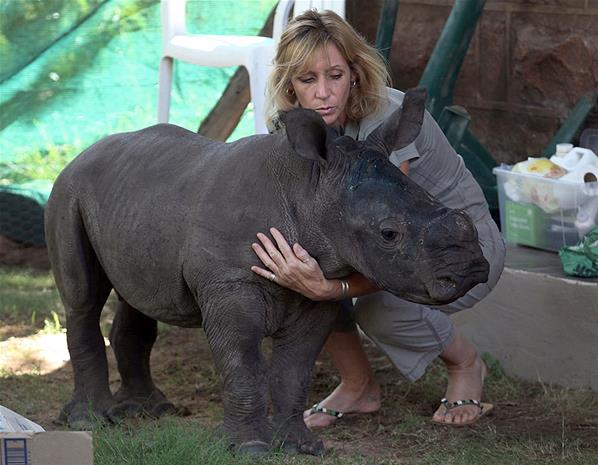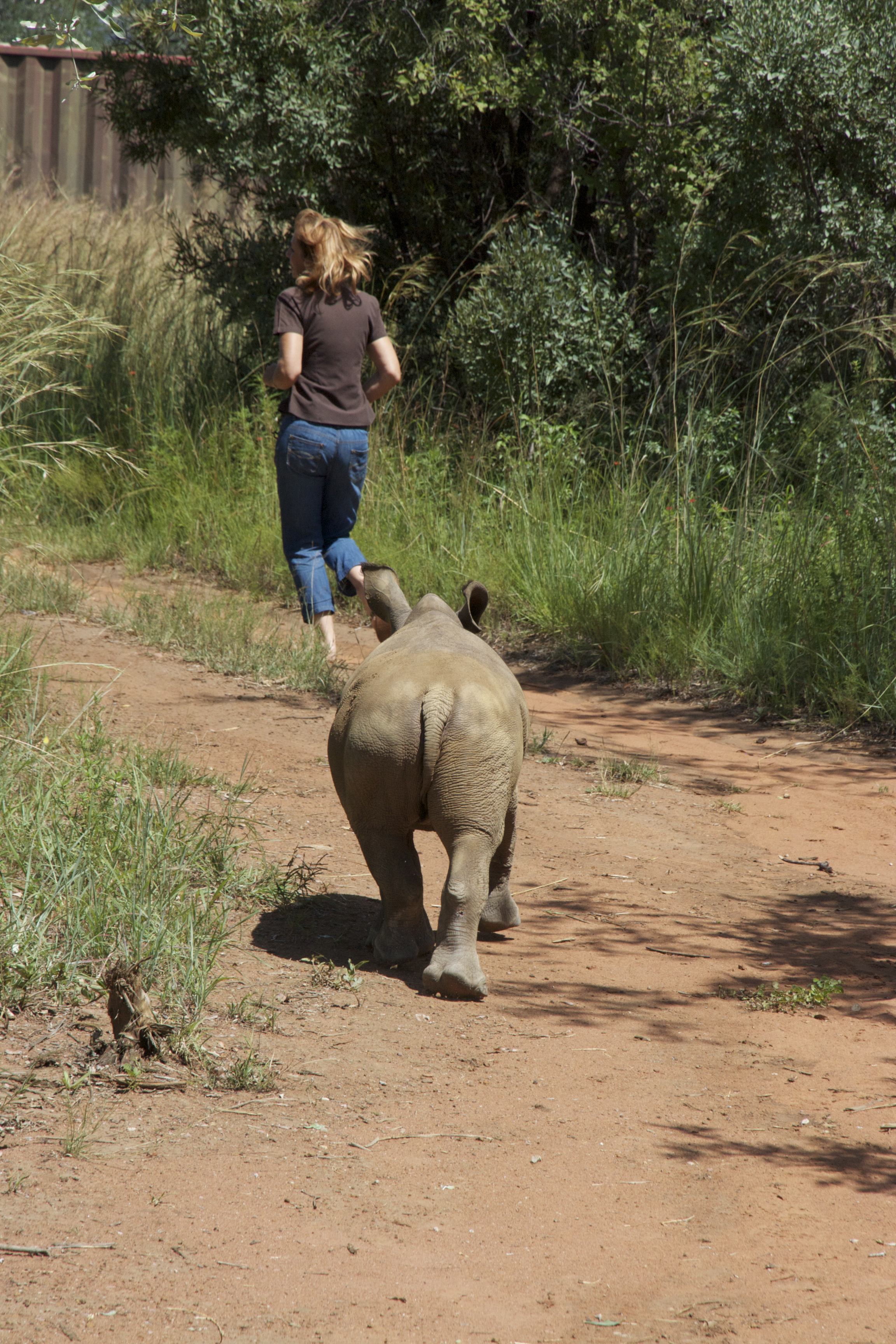Every Calf Counts – The Continental Ties in Rhino Rehabilitation
By Karen Trendler
|
Karen with orphan rhino. Photo Credit: Karen Trendler. |
A tiny prematurely born black rhino calf weighing 24 kg set me up on my life’s mission in 1994. The calf survived against all odds due to beginner’s luck and lots of elbow grease. My first rhino success opened the floodgate for more rescued rhinos, and within a few years, I reared more than 250 rhino calves and nursed as many adults and sub-adults. There was a steep and sharp learning curve for very little was known about hand-rearing orphaned rhino calves and the veterinary fraternity was yet to catch-up with the advances in wildlife medicine. In 2003, I had 35 rhino calves ranging in age from neonatal calves to 2- year-olds at a tiny wildlife rehabilitation facility in South Africa.
I began training workshops on rhino rehabilitation within and outside Africa. The Wildlife Trust of India (WTI) approached me for protocol development in India and I became a resource person for their rehabilitation center in Kaziranga, Assam. Mortality rate in rhino calves was high and we were able to identify and address the causes. Much as it was an incredible opportunity, I was in for a big surprise, when the first one-horned rhino calf I handled bit me. Black rhinos do not have teeth in the front, unlike the one-horned rhino, and I got carried away by the cute Indian rhinos.
Rhino are considered ‘calves’ from birth until three years. The younger calves are milk dependent and need to be bought in for captive rearing; fortunately the rhino are relatively stoic species and with the right handling and facilities, settle quickly. Older calves are much more stressed and do not necessarily need to be bought in for captive rearing. There are risks with bringing an older calf into captivity, maladjustment syndrome being one of the potential problems. The older calves need special consideration and handling. Some of the techniques used include strategic relocations to other areas where there are young adults; and relocation into semi captivity with other youngsters who help to calm the incoming rhino.
The current poaching crisis, part of an international assault on wildlife, driven by greed, corruption and highly organized transnational crime syndicates threatens the 5 rhino species within a long list of endangered wildlife. In a crisis of this nature and extent, the focus, from a conservation perspective moves from protection of populations to saving individuals. This is where responsible and ethical wildlife response and rehabilitation can contribute to the conservation of the species. Rhino populations on a global level are under threat and every calf and casualty counts.
Rhino cows may be more vulnerable to poaching especially when heavily pregnant or with young calves. Rhino mothers are protective of the calves; will remain closer to water and in specific territories. When rhino cow is poached, not only are we losing the potential for future calves, in a breeding cow, we invariably lose a calf and\or fetus and in some cases two calves (some older calves remain with cow, even after the arrival of a new calf). Far too many rhino calves are being orphaned, injured and traumatized by poaching. Increasingly calves are being killed for tiny horn stubs and mutilated for other body parts
In South Africa, as the demands grew, my focus evolved to training and special projects. Life happens when one has other things planned. Rhino poaching started and began to escalate - and with it a demand to assist with injured and orphaned rhino. The Rhino Response Strategy was launched, followed by the EWT Rhino Response Project.
The EWT Rhino Response Project focuses on maximizing survival of calves orphaned or compromised by poaching; and carries out emergency field response as well as facilitating a national network, skills development and capacity building for addressing orphaned calves and casualties. Rhino calves are very appealing and a great draw card for tourists and donors resulting in a number of ‘pay and play ‘facilities. The EWT Rhino Response Project actively promotes responsible, ethical and conservation based rehabilitation with specialized care and protocols aimed at rearing calves in such a manner as to ensure that they grow into healthy, viable self-sustaining rhino for release back into the wild. The ultimate proof of good rehabilitation is when they released animal goes back to the wild and can successfully breed and rear young, thus contributing to conservation.
Our protocols are based on hard-earned hands-on experience. We use only two to three care-givers per rhino with absolute minimum contact with other humans. When bond is broken with the care-giver the rhino goes wild. These techniques work. There are currently a number of rhino that we reared and released that are now free living in the wild with some of the females on their second calves. (Sadly, and an indication of the extent of the crisis some of these rhino have been poached and their calves now in rehabilitative care).
|
Exercising young rhino. Photo credit: Karen Trendler. |
Calves that are incorrectly or inconsistently handled, with exposure to too many people, result in not only unnecessary deaths but also welfare issues, but humanized rhino that are potentially problematic and dangerous. Furthermore rhino that are too tame are more vulnerable to poaching and will not run away when approached by poachers – and may even move towards or seek out that human contact.
Field response experiences indicate that the age and stage of the calf determines its behavior and the type of injuries sustained during a poaching incident. The youngest, tiny calves will do anything to remain with the mother and suffer severe head and facial injuries when the poachers hit out at them with pangas, axes or rifle butts. The slightly older calves will initially run away for a short distance and then try and charge or return to the mother sustaining injuries and gunshot wounds to the legs, chest and face and the older calves are more likely to be shot in the hind quarters, shoulders or nuchal hump. Locating the calves is also a challenge. The younger the calf, the less time we have to locate and capture it before it is too late. Various techniques have been developed to facilitate calf tracking and retrieval.
The levels of trauma experienced by the calves orphaned and often injured by poaching is extreme and we are seeing symptoms and manifestations of Post-Traumatic Stress Disorder (PTSD). The rescue, rearing and rehabilitation of each calf is based on individual circumstances and includes, amongst a wide range of factors -age, sex population composition, security, ability to monitor, predator density, time of year, food and water availability, territory, resources etc.
Not just the rhino directly involved in poaching incidents are affected; we are experiencing stress and disturbances across the whole population. There have also been some interesting adaptations within the population itself and one of the positives has been the incidence of young bulls ‘fostering ‘and protecting younger orphaned calves and females taking on two or three calves (each incident depends on the individual characteristics of the rhino and circumstances - there are no rules or guarantees but sensitive monitoring and adaptive response and rehabilitation need to be applied.
As a wildlife rehabilitator and conservationist, the poaching has been emotionally tough to deal with. I certainly never imagined that I would be doing rescue and stabilization on active poaching scenes; having to work around investigating officers and be concerned about evidence and investigations. Nor did I ever imagine that I would be getting up to feed a calf and have an armed guard looking over my shoulder. The types of injuries and understanding of these has also posed additional challenges and further steep learning curves (bullet wounds, ballistics, knife and panga wounds and patterning and identification) We have also been forced to confront the realities of violent crime in terms of increased amount of mutilations and brutality.
Conservation is faced with growing ‘industrialized’ illegal wildlife trade, of which poaching, is one part. Increasingly responsible, humane, ethical and conservation based wildlife response and rehabilitation can contribute to conservation and fulfill a critical role in addressing the casualties of this war on wildlife.
Karen Trendler is a Consultant Rhino Rehabilitator at Working Wild in South Africa.

